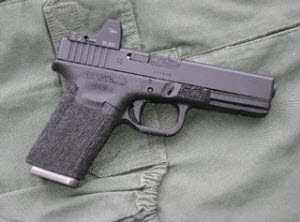
Bowie Tactical Glock with red dot sight. While I don’t recommend building a defensive gun without backup iron sights, I do think the sights are now getting durable enough to consider it.
My experience with red dot sights began when I shot competitively in various shooting sports such as USPSA and Steel Challenge. Years ago, Jerry Barnhart, an elite-level shooter with multiple national championships under his belt, brought a red dot sight mounted on a handgun to a national championship.
Red Dot Sight Benefits
The idea of using a red dot sight on a handgun was definitely outside the box, but its benefits were quickly obvious. Within a few short years, the red dot caused a huge shift in competitive rules, and the “open” division was born because red dot sights were such a competitive edge that iron sights could no longer compete across the board. Why such an advantage? Simple: the red dot sight allows for faster visual reference (the eye picks it up faster), and there is no alignment needed, because with a red dot sight you simply place the dot where you want to hit and pull the trigger.
Another devotee of RDS on a defensive pistol, and the man I consider the father of RDS on fighting handguns, is David Bowie. David runs Bowie Tactical Concepts and has been an avid user and promoter of the concept of RDS on carry handguns for more than ten years. David is known as the go-to guy when getting an RDS mounted on your handgun and/or for information related to their use in this capacity. He is a working deputy Sheriff and SWAT commander for his department’s tactical team, as well as lead instructor for the Tactical Defense Institute. He has been shooting and building fighting guns for many years and definitely knows his stuff. When researching this subject and looking for solutions to get my gun set up, I found David and will be using him to build my test gun, which I will report on in part 2.
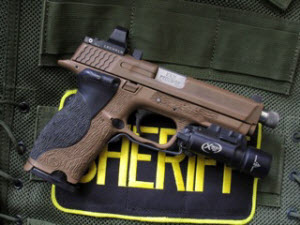
Bowie M&P. This is how I recommend setting up your gun, and how I will have my T&E gun done. David Bowie is known for his knowledge of using RDS on fighting guns.
A red dot sight allows the shooter to continue to focus downrange and simply place the dot on the target. Another benefit of a dot sight is the speed with which it can be used. To use traditional iron sights, the shooter must accomplish multiple things visually, including referencing the front sight, aligning it with the rear, and placing the sights in the center of the target. This is a process that takes time and lots of practice to do quickly. With a red dot, there is only one visual reference to pay attention to, and that is the placement of the dot on the target.
Most trainers agree that the shooter should simply keep his focus on the threat/target and not the dot. A red dot is much simpler to use and, when shooters who have never shot with one are exposed to them, the comment I often get is “This is so easy!”
Another great benefit of a red dot sight is the crossover of the dot when using two weapons systems. Imagine a guy who primarily uses a rifle, like a SWAT officer who has to transition to a handgun for close quarters work or if the rifle fails. With a red dot sight, the user transitions from red dot to red dot and there is no focus shift to a front sight.
Red Dot Sight Downsides
There are some strong benefits to having a red dot sight on a pistol, but what are the cons? You need to be aware of them and find ways to mitigate them for the red dot solution to be viable, so I’ll list each, as well as the potential solution.
RDS are unreliable.
This is less true these days, with sights that are built right by good companies. In the past, sights often failed and the shooter would lose the dot while shooting. The current sights on the market by quality companies such as Trijicon have a good reputation and rarely fail. A second solution is to keep iron sights on the gun and mount them in a manner where they can be seen and used, such as BUIS (backup iron sights) on a rifle.
RDS are bulky and heavy.
While the sights do add some additional weight to the pistol, I think the trade-off is worth it. That being said, I don’t see myself ever mounting an RDS to my Kahr compact carry gun, but do find direct applicability to a full-size gun I might have in a vehicle or at home. In my opinion, a police officer could easily carry one on their duty pistol and never know the difference.

This Safariland holster is only a prototype, but shows that a major manufacturer is designing a holster with the RDS concept in mind.
This is a training issue that can easily be corrected by dry-fire repetitions or simply practicing extending the gun and picking up the dot. The real truth is that competitive shooters have refined this to the point that they are just as fast with the dot up close and much faster at distance.
Current holsters do not fit a handgun with RDS.
This issue is currently being solved by several major manufacturers and will soon be a non-issue. Most sighting systems are now small enough that unless the holster has a locking device, a gun with one on it will still fit without modification.Ready To Try?
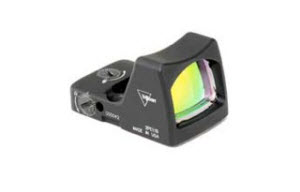
Trijicon RMR offers many features that are necessary in a good RDS. In part 2, I will report on my test and evaluation of this product.
While I’m not sure which one is ultimately the best, there are several features that stand out as important on an RDS.
Battery change.
Changing the battery on some models is only possible by removing the sight from the gun. This causes a problem for military and police officers because they have to re-zero their sights after changing out the battery. Find a sight that allows you to change the battery without removing the sight from the gun.
Elevation and windage adjustment.
In the past, most sights had tension-controlled adjustments, meaning that the user can adjust for elevation and windage but then has to tighten a lock screw down to hold this adjustment. This proved to be unreliable in some cases, but I have personally experienced zero shifts with older model sights. There is at least one company that makes a sight with “click” adjustments, and this is in my opinion the best choice when selecting an RDS. At the least, try to get a sight that has adjustment screws that can be accessed and adjusted with minimal tools (some require a special very small allen wrench).
Dot Size.
Some RDS offer different dot sizes, ranging from a two- to 12-minute dot. Users who have mounted these sights on a rifle as a standard or close-range sight might choose a smaller dot for more precision, but a handgun user will probably want a dot size that is larger and easier to see quickly. I recommend something larger than an eight-minute dot.
On/Off Switch.
Some RDS offer the ability to turn the dot off. If so, ensure you select one that has a recessed switch that cannot be accidentally turned off. Imagine having to use the sight in a high-stress encounter only to find it’s off. While I don’t think an on/off switch is absolutely necessary, it’s a nice option if you want to do some training with your iron sights.
Durability.
This one is obvious but key. The sight should be shock proof, waterproof, and strong enough to allow the sight to be hooked onto a belt or holster for one-handed manipulations.
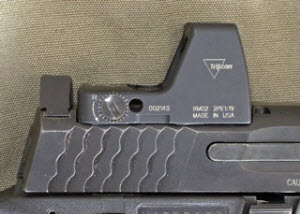
RDS mounted in front of rear sight. Problem is that this places the RDS closer to the ejection port and may cause more debris to get on the scope lens.
Mounting the RDS
Once you get your sight, the next step is mounting it to the handgun. This is critical and must be done right if you expect the sight to hold up. My suggestions for mounting the sight on your handgun are:
Mount the sight lower in the slide (you will need a good gunsmith for this), with some sort of securing posts to keep the sights from rotating left and right.
You have to contend with the irons. Here are the options:
Mount the RDS and remove the rear sight, leaving only the front as an indexer that helps you pick up the red dot faster.
Mount the RDS in front of the rear sight and leave the sights as they are. This mounting requires that the RDS can be mounted low enough into the slide to still see the sights.
Mount the RDS and move the rear sight forward of the optic. This is currently the solution I might recommend, simply because it allows the glass in the RDS to remain clean and clear of oil and junk that will come from the barrel/chamber area during shooting. It may also be easier to hook the rear sight on something for one-handed clearances if it is mounted in front of the RDS.

This shows how you can view the iron sights through the red dot scope. If the dot goes out during an engagement, simply pick up the irons and fire. The irons are also said to help the user find the dot faster.
In Closing
Watch the future: red dot sights are coming, and coming fast. I strongly believe you will see them on a large percentage of full-sized handguns used for operational purposes sometime in the near future. If you have a problem using your current sighting system due to vision issues, it might be time to try something different!
Special thanks to David Bowie for the photos and support of this project.
Check out the Future of Defensive and Red Dot Sights, Part 2: Testing and Evaluation
Share tips, start a discussion or ask one of our experts or other students a question.
Already a member? Sign in
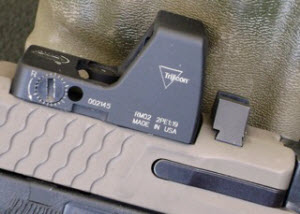

I just ordered a Kydex holster from "Multi Holsters". Need an impossible to find holster? Call these guys! I have an HK P2000SK with a Viridian Tac light, and a Red Dot sight being mounted and, yes, as rare as this pistol is as equipped, Multi Holsters is making it for me. Nope, I don't work for them, but I am endorsing them since no one on earth could fill this order after extensive research. Cheers.